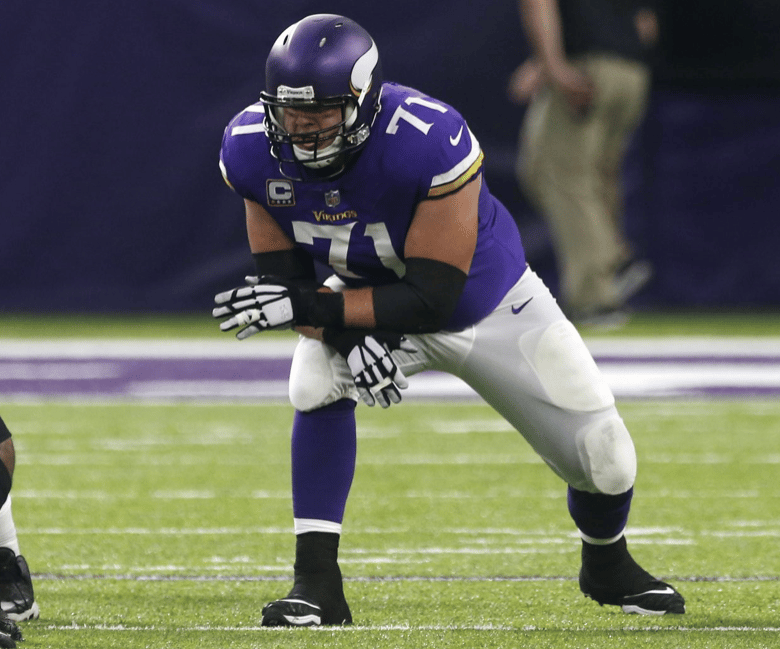What will the Vikings do with Riley Reiff?

Since the Minnesota Vikings are strapped up against the salary cap for the 2021 season, they’ll likely be forced to part ways with some key contributors, one of whom could be LT Riley Reiff.
Reiff, 32, is coming off arguably the best season of his life, and he is slated to make 13.9 million dollars next season, the final year of his contract, per Over the Cap. In the 2020 season, Reiff started 15 games for the Vikings, allowing just one sack and 21 pressures.
In April 2020, the Vikings drafted Ezra Cleveland out of Boise State, presumably as the heir to incumbent Reiff However, Reiff’s resurgence creates a boatload of questions and opportunities for the Vikings LT and offensive line situation as a whole.
I ran through some scenarios surrounding what Minnesota can do.
1. Extend Riley Reiff
Riley Reiff signed a five-year contract worth $58.75 million. in March 2017. He is slated to be a free agent after the 2021 season, and his 2020 salary cap hit is $13.95 million. The Vikings are short on money this season, but there is a good chance that they may not be keen on letting their best pass blocker leave.
If they believe Reiff can follow the trajectory of his resurgence, Minnesota could extend him. This could reduce Reiff’s 2021 cap hit and keep continuity on their offensive line.
For Ezra Cleveland, this means that he continues his stint at guard. In 2020, at RG, Cleveland allowed five sacks and 23 pressures in nine starts. Cleveland graded 29th among qualifying guards per Pro Football Focus.
Chances are, however, that Reiff does not want an extension. A few weeks before the season, the Vikings made the trade for DE Yannick Ngakoue, and to make space for his contract, they approached Reiff with the ultimatum of taking a pay cut or being released. It took many days, but Reiff decided to stay in Minnesota. The Vikings ended up trading Ngakoue a few weeks later.
Coming to an agreement with the Vikings on a reduced deal is no longer the only option for Reiff. After 2020, he could likely find any money on the open market.
2. Move Riley Reiff to Guard
This proposal has been one of intrigue to most of the Vikings fan base since last April:
“The Vikings don’t have a left tackle (Riley) Reiff did an admirable job at left tackle last year but that’s not what he is. He’d be better served for him & his career moving forward if he played any other offensive line position but center.”
Mike Tice, Former Vikings OL Coach
Reiff last year said the Vikings talked to him about possibly moving to guard but he said they didn’t this year: “I didn’t hear anything about that. I’ll play whatever as long as it helps the team.”
If the Vikings moved Reiff to guard, it comes with the possibility of a reduced salary cap hit, which would benefit them as well. However, this likely means that they feel confident in starting Cleveland at LT.
3. Cut Riley Reiff
The final possibility is probably the boldest one yet. Through this move, Minnesota loses practically all of its continuity. However, this move has the most upside potential.
If the Vikings cut Reiff, they would likely slide Cleveland to left tackle, leaving holes at the guard spots. The Vikings cutting Reiff would save the team around $11.75 million. Minnesota could look to flip some of that money on a free agent, veteran guard like All-Pro Joe Thuney of the Patriots, or even cheaper options like Jon Feliciano of the Buffalo Bills and Austin Blythe of the Los Angeles Rams.
They could even opt to spend the money obtained from letting Reiff go on other roster holes and using a high draft pick on the offensive line.
While this move gives Minnesota the most flexibility, it does present the most “bust potential” since Cleveland hasn’t played a single snap at left tackle in the NFL.
If the Vikings believe that Cleveland can be a competent piece at left tackle it may be best to move on from Riley Reiff. If not, they will have to look in other places to manage the salary cap.
